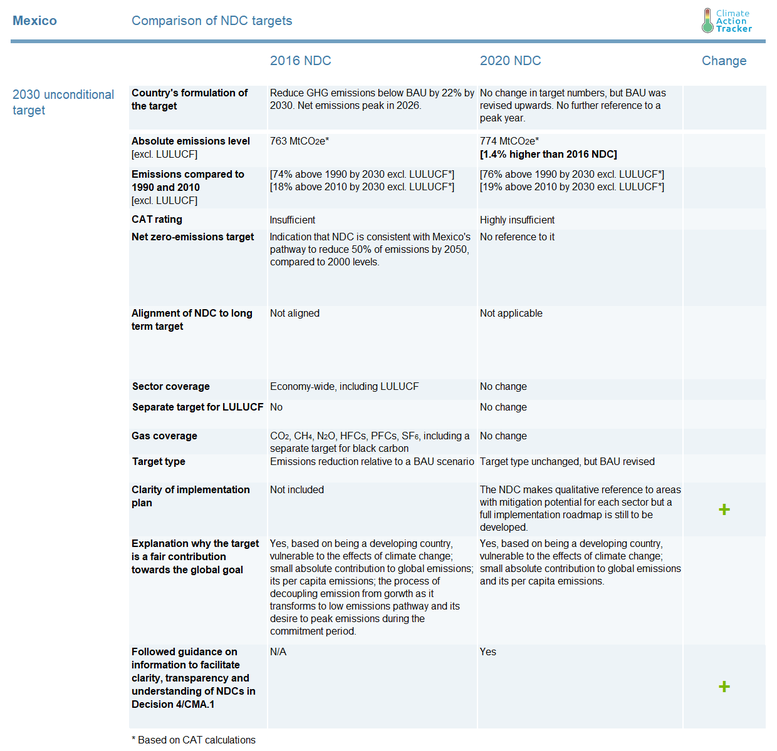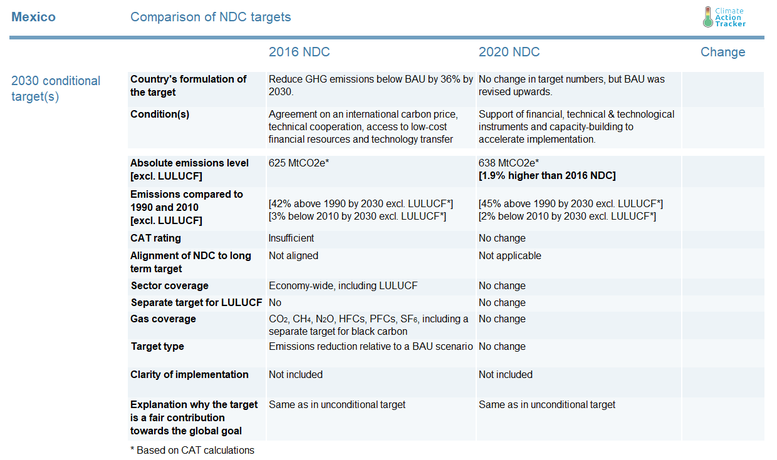Summary
Mexico’s updated NDC lowers its climate ambition and transparency, contrary to Paris Agreement rules
Mexico submitted its updated NDC on 30 December 2020: its targets, both conditional and unconditional, remained unchanged, while its emissions projections under business-as-usual (BAU) continue to increase. This reduces the country’s mitigation ambition in absolute levels and moves the rating of this target one category lower to “Highly insufficient.” The failure to increase its mitigation ambition for 2030 does not comply with the Paris Agreement’s requirement that each successive NDC should present a progression beyond the current one.
CAT analysis of the unconditional target


Mexico submitted its updated NDC on 30 December 2020, committing to unconditionally reduce its emissions by 22% below a business-as-usual (BAU) scenario by 2030 and up to 36% below BAU, conditional on receiving financial, technical and capacity building support.
These targets are the same as those included in the original 2016 NDC. However, the BAU associated with these targets has been revised upwards in the NDC update, with a total emissions level in 2030 higher than that reported in the 2016 NDC, which we used in our previous assessment (September 2020). Given the NDC is defined as a percentage reduction below BAU projections, a higher emissions level in 2030 effectively reduces the country’s mitigation ambition, even if the reduction targets remain unchanged.
The updated NDC is also less transparent than the original 2016 submission, which makes assessing the level of ambition more difficult. In the original 2016 NDC, Mexico included a sectoral breakdown of the BAU as well as a breakdown of each sector’s contribution to achieving the unconditional target. The updated NDC only contains the sectoral breakdown for the BAU.
The revised BAU reports slightly lower numbers in 2030 for the transport, power and oil & gas sectors while projecting higher 2030 emissions for the agriculture, industry, and waste sectors.
Similarly, for the land sector (i.e. land-use, land-use change and forestry (LULUCF)), the 2016 NDC projected sector emissions under BAU to stay at constant levels until 2030, and to become a small sink as part of achieving the unconditional target. The updated NDC projects a growing emissions contribution from this sector under BAU, and no estimates were provided as to its expected contribution under the unconditional target. The LULUCF contribution to the target’s emissions reduction is a key element for our analysis and can substantially impact our results (for more information, see the assumptions section below). Overall, the new BAU scenario estimates an increase in emissions of almost 2% in 2030.
Mexico’s updated NDC reports emissions levels in 2030 using Global Warming Potentials (GWPs) from the IPCC 5th Assessment Report (AR5) which we converted to GWPs of the IPCC’s Fourth Assessment Report (AR4). Our calculations of the emissions level for the NDC targets, excluding LULUCF emissions, is:
- Unconditional target: 774 MtCO2e in 2030 (previously estimated at 763 MtCO2e)
- Conditional target: 638 MtCO2e in 2030 (previously estimated at 625 MtCO2e)
The slightly higher emissions level under the unconditional target moves Mexico’s rating one category lower from “Insufficient” to “Highly insufficient” indicating that Mexico’s updated NDC is not consistent with holding warming well below 2°C, let alone limiting it to 1.5°C, and is instead consistent with warming levels of between 3°C and 4°C.
Mexico’s failure to increase its mitigation ambition breaks the Paris Agreement’s requirement that each successive NDC should present a progression of a country’s mitigation efforts, beyond the current ones. This is a step backwards when Mexico should have used the opportunity to come up with a more ambitious target aligned to the Paris Agreement. It also fails to recognise that a fair contribution requires higher emission reduction rates.
The updated NDC has expanded the adaptation section to be much more prominent than in the previous submission. During the public consultation process, the changes and advancements in the adaptation component took a central role, while discussions on the unchanged mitigation targets were limited. A target of net zero deforestation rate by 2030 is included as part of the “Conservation, restoration and sustainable use of biodiversity and ecosystem services” section in the adaptation chapter.
The updated NDC makes no mention of a net-zero target, nor Mexico’s commitment to reduce emissions by 50% below 2000 levels in 2050 which was referred to in its first NDC submission and in its “Climate Change Mid-Century Strategy” submitted in 2016. This is not in line with the Paris Agreement temperature goals and Mexico should transition to a target of net-zero emissions in the second half of the century.
CAT analysis of the conditional target

As mentioned above, the submitted NDC contains a conditional 2030 target of up to 36% reduction below BAU by 2030, dependent on access to financial, technical and capacity building support. This target has not changed compared to the one submitted in 2016. However, given that the BAU has been revised and now includes a higher emissions level for 2030, the same conditional target now leads to higher absolute emissions level for 2030 than previously pledged. Mexico’s emissions under its conditional target now leads to 638 MtCO2e in 2030 (previously estimated at 625 MtCO2e). Our rating of this targets remains “Insufficient.” No further details have been provided for the conditional target (e.g., sectoral contribution to the target), making it difficult to assess.
Details of other supporting targets
The updated NDC included targets to reduce black carbon (BC) between 51%-70% below BAU as part of both the unconditional and conditional targets, which has substantial co-benefits for human health. However, given that reductions in BC are generally not additional to those in CO2 emissions because large fractions of black-carbon emissions stem from the same emission sources as CO2, we do not quantify the additionality of the BC target. For more information on our approach to black carbon, please see the assumptions section of our full country analysis.
Assumptions
Global Warming Potential (GWP) values
The NDC baseline is taken directly from the NDC submission, which reported emissions using Global Warming Potentials (GWPs) from the IPCC 5th Assessment Report (AR5). To convert from AR5 to AR4 values, we have used an average conversion factor based on Mexico’s historic timeseries (1990-2017), as its inventory provides a granular information on all gases and sectors.
LULUCF
We calculated the unconditional NDC target as the 22% reduction below the baseline scenario (including LULUCF emissions), as indicated in the NDC (Mexico reports LULUCF removals separately).
Mexico has not provided information on the extent to which reducing LULUCF emissions will contribute to achieving its NDC target. To exclude LULUCF emissions, we have assumed Mexico will achieve the same sink, as reported in the 2016 NDC, and have deducted that amount from the 22% emission limit. For the conditional target (36% below baseline), we assumed the same contribution for the LULUCF sector as for the unconditional target. A higher baseline and a constant contribution of the LULUCF sector lead to higher emissions level under the mitigation targets.
By contrast, if Mexico anticipates that the LULUCF sector will contribute the same percentage (rather than absolute amount) as provided for in the original NDC, Mexico’s unconditional target would remain the same as in its first NDC. This uncertainty only serves to highlight the need for countries to be transparent in the extent to which they intend to reply on the land sector to achieve their NDC targets.
Links
Stay informed
Subscribe to our newsletter


